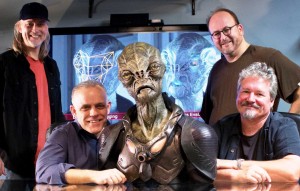
This year, the company implemented its new dMFX digital enhancement process, which mixes on-set special FX creature work with proprietary digital tools, in order to create the unique alien beings featured in season four.
MASTERSFX has been involved with the series since the pilot episode, creating armies of practical monsters, from small parasites, to the 12- foot tall spindly “Overlords” and car-sized “Skitters.”
“A lot of the fun of this show is the creative force behind the stories,” said company president and founder Todd Masters. “Every week, when we receive the new scripts, we salivate – like the show’s fans – because we are very excited to see what the writers have conjured up next. And we also enjoy challenging ourselves to see if we can fulfill those challenges.”
Over the course of the first three seasons of the series, MASTERSFX, working from studios in L.A. and Vancouver, has developed techniques to better integrate practical effects with modern digital visual effects. The company first deployed its unique digital process with the creation of the “Volm” alien race.
“Even the most unruly critters were somehow engineered to believably arrive on set,” said Masters. “The 12 foot tall alien Overlord characters were created at actual-size and lensed in-situ, in motion, as portrayed by real actors on leg-extensions. Later, to depict the creature’s demeanor, we integrated expressive alien eyes and emotive facial features by using our dMFX process during postproduction.”
The dMFX process incorporates digital techniques into the on-set practical effects. “Our dMFX process allows us to integrate more traditional creature and character FX techniques with high-end tracking, photo-processing and performance transfer, to solve monster problems for our clients, in a highly efficient way,” said Masters. “Achieving great characters for commercials or producing interesting new creatures for film and television is no longer just for big budgeted projects.”
“As artists, working in both makeup and visual effects, we prefer to embrace any tool or technique appropriate when helping our clients tell compelling stories,” explained André Bustanoby, dMFX visual effects supervisor. “In Falling Skies, for example, the alien characters are an unique amalgam of techniques, built by our studio between our makeup and digital divisions, thus sharing the same artistic direction and goals. One mind, one monster. With too many cooks in the kitchen, the effective depiction of unique characters can get easily out of control or lose design cohesion. At the end of the day, helping create an organic, relatable character, in service to the story – is paramount.”
Falling Skies’ new alien character Cochise was introduced to the series at the beginning of season three. Cochise is a warrior of the Volm alien race, portrayed by actor Doug Jones. Jones has also performed as several other members of the Volm species, including his own father in last season’s finale.
The dMFX process helps to embellish Jones’ performance, allowing him to drive the digital enhancements of his Volm characters. The dMFX system analyzes the actor’s original performance and super-sizes it, relying on proprietary methods. The MASTERSFX team then blends together the on-set prosthetics, Jones’ performance and the digital enhancements crafted in post.
“The character of Cochise… is a combo platter of both practical and digital techniques, all under the MASTERSFX umbrella,” said Jones. “I always prefer to wear prosthetic makeups on set when I’m playing other-worldly characters. This allows for normal interaction with the other actors in each scene, since they are able to talk with this alien character during a scene. Over the years, I’ve also noticed that wearing prosthetic makeups actually affects my posture and gestures, and makes me move and react differently.”
The company’s Vancouver team, led by creature art director Werner Pretorius and onset makeup artists Felix Fox and Maiko Gomyo, deliver Jones’ practical prosthetics – created fresh every morning. Even though the practical version of Cochise is limited in movement, Jones’ character appears on-set in every detail. This is done so that other actors can better relate to his characterizations, and so that he can be physically present in the scene. Jones can be directed and involved in his scenes, interacting with other cast members, as well as with the sets and props. Historically, this approach has been very difficult, if not impossible, with traditional visual effects.
“I love the practical side of FX. And now, by adding in the digital side, the MASTERSFX team is able to make my eyes blink and look around, my upper lip can move along with my dialogue, my eyebrows can express emotion, and the muscles in my face can move in concert with my speaking voice,” said Jones. “MASTERSFX makes my performances seamless – they give life and breath to the prosthetic face by adding digital subtleties that don’t make Cochise feel like he’s a character within a video game.”
“Our goal with Falling Skies is to subtly and appropriately embellish the live, on-set performances of actors who are representing alien creatures and wearing prosthetics,” said Johnathan Banta, senior visual effects supervisor. “It provides the benefits of an actor actually being on-set, lit, and performing along with the rest of the cast. Afterwards in postproduction, we are able to provide subtleties and an organic sense of reality to the performance of Doug Jones, bringing in the ‘missing life’ that was not captured, due to the limits of the prosthetics.”





